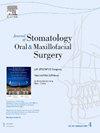可吸收镁与钛拉力螺钉用于下颌联合骨折固定的生物力学比较:有限元分析。
IF 2
3区 医学
Q2 DENTISTRY, ORAL SURGERY & MEDICINE
Journal of Stomatology Oral and Maxillofacial Surgery
Pub Date : 2025-10-01
DOI:10.1016/j.jormas.2025.102383
引用次数: 0
摘要
目的:应用有限元分析(FEA)评价镁生物可吸收拉力螺钉与传统钛螺钉在下颌联合骨折固定中的生物力学性能。材料与方法:使用MIMICS软件根据高分辨率CT数据制作三维下颌骨模型。模拟骨折线,在SolidWorks中设计Mg和钛螺钉并虚拟植入。采用三维软件进行网格划分,以准确表示几何形状。采用ABAQUS软件在150 N(门牙载荷)和550 N(磨牙载荷)的咀嚼力作用下进行有限元分析。评估应力分布、位移和断裂稳定性,并根据已建立的数据得出材料性能。结果:在两种载荷条件下,Mg螺钉的von Mises应力(VMS)均低于钛螺钉。对于切牙负荷,Mg螺钉为44.71 MPa,钛为56.94 MPa, Mg螺钉的应力最低(25.73 MPa)。同样,在摩尔载荷下,Mg螺钉显示出更低的应力(48.35 MPa比钛的61.53 MPa)。不同材料的下颌应力(22.158 ~ 23.14 MPa)、螺钉变形(0.230 ~ 0.255 mm)和骨折位移(0.278 ~ 0.310 mm)具有可比性。讨论:Mg螺钉表现出与钛螺钉相当的生物力学稳定性,同时显著降低应力集中,有效地在骨愈合限度内传递载荷。它们的生物可吸收性消除了二次手术的需要,为下颌骨骨折固定提供了一个有希望的选择,提高了临床效果。本文章由计算机程序翻译,如有差异,请以英文原文为准。
Biomechanical comparison of magnesium bioresorbable and titanium lag screws for mandibular symphysis fracture fixation: A finite element analysis
Objective
This study evaluates the biomechanical performance of magnesium bioresorbable lag screws compared to conventional titanium screws for mandibular symphysis fracture fixation using finite element analysis (FEA).
Material & Methods
A 3D mandible model was created using MIMICS software from high-resolution CT data. Fracture lines were simulated, and Mg and titanium screws were designed in SolidWorks and virtually implanted. Meshing was performed using 3-matic software to represent geometry accurately. FEA was conducted using ABAQUS under masticatory forces of 150 N (incisor load) and 550 N (molar load). Stress distribution, displacement, and fracture stability were assessed, with material properties derived from established data.
Results
Mg screws exhibited lower von Mises stress (VMS) compared to titanium screws under both loading conditions. For incisor loading, Mg screws recorded 44.71 MPa compared to 56.94 MPa for titanium, with the lowest stress in Mg screws (25.73 MPa). Similarly, under molar loading, Mg screws showed reduced stress (48.35 MPa vs. 61.53 MPa for titanium). Mandibular stress (22.158–23.14 MPa), screw deformation (0.230–0.255 mm), and fracture displacement (0.278–0.310 mm) were comparable across materials.
Discussion
Mg screws demonstrated comparable biomechanical stability to titanium screws while significantly reducing stress concentrations, effectively transmitting loads within bone healing limits. Their bioresorbable nature eliminates the need for secondary surgeries, offering a promising alternative for mandibular fracture fixation and enhancing clinical outcomes.
求助全文
通过发布文献求助,成功后即可免费获取论文全文。
去求助
来源期刊

Journal of Stomatology Oral and Maxillofacial Surgery
Surgery, Dentistry, Oral Surgery and Medicine, Otorhinolaryngology and Facial Plastic Surgery
CiteScore
2.30
自引率
9.10%
发文量
0
审稿时长
23 days
 求助内容:
求助内容: 应助结果提醒方式:
应助结果提醒方式:


